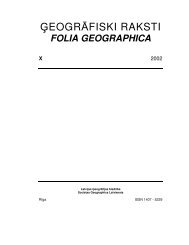eogrÄfiski raksti folia geographica xii - Ä¢eogrÄfijas un Zemes zinÄtņu ...
eogrÄfiski raksti folia geographica xii - Ä¢eogrÄfijas un Zemes zinÄtņu ...
eogrÄfiski raksti folia geographica xii - Ä¢eogrÄfijas un Zemes zinÄtņu ...
You also want an ePaper? Increase the reach of your titles
YUMPU automatically turns print PDFs into web optimized ePapers that Google loves.
57<br />
MAN AND ENVIRONMENT<br />
important [Grīne et al. 2003]. The farmer’s wish to cultivate his own land – something that he<br />
had been forbidden to do for years – and to supply his family with food, is the determinant<br />
factor of land use in the Latvian agricultural landscape.<br />
The aim of this article is to analyse factors which have determined land use in Gudenieki<br />
parish of the Kuldīga district during the previous century. The results obtained form the basis<br />
for forecasting the probable transformations of the landscape when economic factors will<br />
determine land use.<br />
Sources and Methods<br />
Gudenieki parish is situated in Western part of Latvia (Figure 1). The population in 2004<br />
was 882 people. Only 31% of the population lived in villages (Gudenieki, Birži). The parish has<br />
one of the greatest densities of population and largest number of detached homesteads in the<br />
Kuldīga district [Kūle, Rasa 2001]. The territory <strong>un</strong>der discussion is an outlying district of<br />
Kuldīga district, comparatively far from the main highways and economically active centres.<br />
Figure 1. Location of the Gudenieki parish<br />
At the beginning of the 21st century Gudenieki parish had one of the lowest indices of<br />
development in the Kuldīga district. People’s income was low too [Bauere (ed.) 2003].<br />
Agricultural lands occupy 57.5% of the land (or 6468 hectares). Gudenieki parish excels among<br />
other parishes of Kuldīga district with the largest amo<strong>un</strong>t of arable lands – 75.7% [Nikodemus<br />
2000]. 63.4% of the agricultural lands have been reclaimed by improved drainage.<br />
Natural conditions in the parish are diverse. The eastern part of the parish is occupied by<br />
the Kurmāle Hillock (Figure 2). The mosaic type of landscape structure is determined by the<br />
<strong>un</strong>dulating relief, loamy and sand-loamy soils, and variation in moisture content. The central<br />
part of the parish is occupied by the flat Apriķi Plain where clay soils predominate. The plain<br />
has been well – cultivated with arable lands predominating. The western part is occupied by<br />
Piemare Plain covered by forests. Here sandy soils predominate.

















